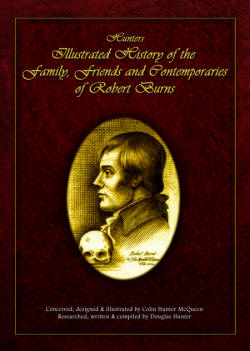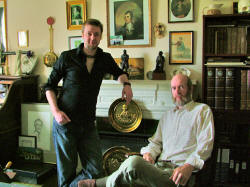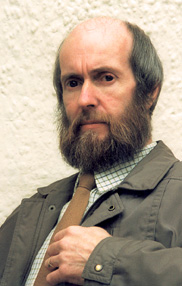|
 Q:
Many books, actually thousands, have been written on Robert Burns, most
destined for back library shelves as dust collectors and rarely, if ever, to
be used. But then a few, like yours, are destined for front-row status for
use by scholars and laymen alike for years to come. How did you come up with
this idea of a pictorial history as well as the necessary text? Q:
Many books, actually thousands, have been written on Robert Burns, most
destined for back library shelves as dust collectors and rarely, if ever, to
be used. But then a few, like yours, are destined for front-row status for
use by scholars and laymen alike for years to come. How did you come up with
this idea of a pictorial history as well as the necessary text?
A: From an extremely early age, painting, drawing and sculpture were
the loves of my life, to enjoy, absorb and practice. It is therefore quite
natural that my work in book form should depend predominately on
illustrations. The text I had envisaged would have been more simplistic,
however, my thanks go to Douglas who has so ably extended, executed and
enhanced the volume. He has scrupulously researched every entry through all
available avenues and has at time caused his father great pain by adding not
just a few new obscure people to the list which unfortunately hastened me
back to the drawing board. The idea for the volume came while I was perusing
a decorative book of Burns’s Tam o’ Shanter, with
illustrations by George Cruikshank, the London-based Scottish artist who was
responsible for the original visual images of many of Charles Dickens’
characters. It also followed that after Rantin’, Rovin’
Robin, it seemed to me obvious that a similar treatment was needed
for his family, friends and contemporaries, although on a much grander scale
in full colour/sepia. (Colin)
Q: Douglas, since the book was researched, written and compiled by
you, please tell us what you wanted to achieve to make your book more than
just “another” book on Burns?
A: For me the book was already a different approach due to its
illustrations. The initial idea was for me just to write a ‘potted history’
of each individual featured; however, as more and more research was
completed and anomalies in dates, etc., were discovered (we managed to
uncover over three hundred birth, baptism, proclamation, marriage, death,
burial and inventory records), it was clear to tell a proper story of each
individual that the allotted space in the book for this ‘potted history’
would not be enough. Therefore, we decided to extend each person’s story to
an additional notes section at the end of the book. One of the joys of
writing the book was researching some of the less written about characters
associated with Burns, such as Dr. Charles Fleeming, Matthew Henderson and
Provost Charles Hamilton of Craichlaw. What I really wanted to achieve was
to produce a text to do justice to the quality of the illustrations.
(Douglas)
Q: Again, Douglas, give us a few examples of new information
regarding the Bard or his family that you discovered and that are in the
book.
A: To answer this question and give you examples, it’s probably best
just quoting you a couple of passages from the book:
‘Another interesting discovery I made while researching Dr. Fleeming was
that he is buried next to another Irvine surgeon, Dr. Thomas Walker (born in
Dundonald on the 2nd of August 1759, baptised on the 8th of August, and died
in Irvine on the 17th of March 1833). Dr. Thomas Walker was the son of Rev.
Thomas Walker of Dundonald and Ann Shaw; therefore, the younger brother of
Burns’s associate, Prof. Josiah Walker. From the various names on the graves
it became quickly apparent that Dr. Fleeming and Dr. Thomas Walker were
connected. Walker’s wife was Mary Fleeming, daughter of Dr. Charles Fleeming
and Mary Montgomery (born in September 1766, and died on the 4th of
September 1840). Amongst their children were Charles Fleeming Walker and
Josiah Walker. Also in the grave to the other side of Dr. Fleeming is buried
the Rev. Hugh Jaffrey, who was married to Thomas Walker’s fifth daughter,
Millicent Rebecca Fleming.’
‘It has been previously accepted that the marriage of Gilbert Burns and Jean
Breckenridge took place at a first-floor flat in a house on the corner of
Waterloo Street and Green Street, Kilmarnock, on the 21st of June 1791, the
site now occupied by the bus terminal. However, in collating the information
for this book I discovered in the parish records of Mauchline that in 1791
‘Burns Gilbert in Mossgiel & Jean Breakenrigg in the Parish of Craigie were
contracted and married at Craigie 20th June’. It is possible, however, that
the reception may have been held on the 21st of June in Kilmarnock.
Interestingly, directly below the entry for Gilbert and Jean in the parish
record is an entry which shows the marriage of Burns’s friend, John
Richmond.’ (Douglas)
Q: Colin, ten years ago you gave Burnsians all over the world another
excellent book, Rantin’, Rovin’ Robin, An Illustrated Life Story of
Robert Burns. Since that book was also illustrated, what is the
difference between the two books relative to the
illustrations?
A: Rantin’, Rovin’ Robin, the chronological life of
Burns, allowed freedom of imagination and composition where illustrating was
concerned. However, one had at the same time to ensure that all inanimate
objects were of the particular period. The illustrations in the present
work, especially portraits, architecture and memorials had to be as accurate
as possible. This multiplied the time spent in research and execution, and
an even style had to be maintained throughout the volume. A certain amount
of artistic freedom was available where imaginary images were necessary. I
suppose the present work was from time to time more painstaking since it
took three times as long as Rantin’, Rovin’ Robin and from
conception to completion research in the field was periodically necessary.
(Colin)
 Q:
Colin, you have tremendous artistic talent. When did you become interested
in art? Did you study in the field? Tell our readers a little bit about
the process of becoming a successful artist. Q:
Colin, you have tremendous artistic talent. When did you become interested
in art? Did you study in the field? Tell our readers a little bit about
the process of becoming a successful artist.
A: I was about four when I first doodled with a pencil and modelled
with plasticene and to my eternal shame I used one of the family Burns books
as drawing material. When I was nine I had cultivated some natural ability
in the visual arts, so much so, that my primary head teacher called in my
mother (my father died two years earlier) and advised her that he had
arranged for me to attend Jean Irwin’s Saturday morning art class in Glasgow
Art Gallery and Museum - from where I had early work exhibited. Whilst
serving my time as a pattern-maker I attended evening life classes for
drawing and sculpture in Glasgow school of art. I later worked for some
time at a monumental sculptor’s yard before joining the Glasgow Museums. To
be a successful artist or indeed successful at anything requires a modicum
of natural ability, a love for the subject and life long practice. (Colin)
Q: Colin, I know you conceived, designed and illustrated the book,
but when did you take your dream and turn it into reality? How long did it
take you to complete the book from conception to completion?
A: As I answer this question, Frank, we are still employed putting
the finishing touches to the volume. When I say we, it should be noted that
Tracy Carmichael, Douglas’s fiancé, has been indispensable to the cause.
From conception in 2001 it has taken until now to complete work on the
volume. (Colin)
Q: Douglas, how many sites did you and your father visit to come up
with the text and illustrations of this book? Can you mention some of the
more unusual sites visited, as well as any unusual events that took place
going from site to site? Approximately how many miles did you two put on
your cars?
 A:
We travelled the length and breadth of Scotland searching through graveyards
and various other historical sites, taking thousands of photographs as
reference material not only for the illustrations, but also for the text.
It’s difficult to say how many sites we visited, but our journeys took us
to some interesting places, and not a few arguments trying to find them with
various fights over the maps! I must also mention that Tracy Carmichael who
is now putting the book together doing the graphic work and typesetting (and
various other things) came to help us on many occasions. A:
We travelled the length and breadth of Scotland searching through graveyards
and various other historical sites, taking thousands of photographs as
reference material not only for the illustrations, but also for the text.
It’s difficult to say how many sites we visited, but our journeys took us
to some interesting places, and not a few arguments trying to find them with
various fights over the maps! I must also mention that Tracy Carmichael who
is now putting the book together doing the graphic work and typesetting (and
various other things) came to help us on many occasions.
It’s quite hard to just pick a few places we visited to talk about, since
there were that many. One that immediately springs to mind is St Quivox
Church in Ayrshire, where we were very fortunate to be taken along with Jim
Gibson of the Kilmarnock Burns Club, into the vault of the Oswald Family of
Auchincruive by the Rev. David Ness, where the carpets were rolled back for
us to photograph the grave-stabs.
Sadly, many of the graveyards (mainly in the cities) we visited were in a
poor condition, many of the gravestones had been pushed over and lay broken
on the ground. Many of the graveyards of Glasgow and Edinburgh are probably
not places to go wandering in alone. In Edinburgh we came across people
sleeping in tombs, and on one occasion injecting drugs only a few yards away
from tourists, and worse… not to mention here. (Douglas)
Q: Colin and Douglas, regarding Burns, with the exception of his own
poems and songs, which three books about him influenced you more than all
the rest and, if marooned on an island, you would want to have with you?
A: I think we are both in agreement that we would probably like James
Barke’s novels with us, however, since it’s just three books allowed, then
the Complete letters, Complete works and Biography of Burns all by the late
Dr. James Mackay ( he was a good friend of the family) would be the obvious
choice. (Douglas)
 Q:
Colin and Douglas, who was instrumental in introducing Burns to you? What
was there about Burns that led both of you to spend your lives as students
of the Bard? Q:
Colin and Douglas, who was instrumental in introducing Burns to you? What
was there about Burns that led both of you to spend your lives as students
of the Bard?
A: My father’s people hailed from the countryside around Falkirk,
Linlithgow and Slamannan. They settled in Glasgow in the early 1900s. It was
during walks with my father in Glasgow when as a very young child I was
frequently introduced to Burns by way of a large seated marble statue which
was situated in an alcove near Charing Cross. That, coupled with the
musical evenings around the piano in my grandparents’ house where we lived,
laid the seeds for my interest in the Poet. My wife Alison maintains that
Burns has taken over my life and soul, and like your good self, I am a
victim of the collecting disease. (Colin)
I can’t remember a time that I was unaware of Burns; I grew up surrounded by
my father’s paintings, sculptures and plaques of Burns. My real ‘passion’
for Burns’s works comes from the fact that I am a singer, song-writer, and
can find no greater source of inspiration. ‘The Court of Equity’, one of my
bands, plans to record a CD of Burns music and song later in the year.
(Douglas)
Q: Is there another book in the future from either or both of you? If
so, can you give our readers a sentence or two about subject matter(s)?
A: We are indeed working on another book at the moment, but we are
not quite ready to reveal its subject matter. You will be the first to know.
(Douglas)
Q: I really appreciate your courtesies and cooperation during the
book review and “chat” process. Is there a last word or two that either of
you would like to share with our readers?
A: We sincerely hope that the labours of our work will satisfy and
inform our subscribers, be they scholars or layman or any others who happen
to procure a copy of this, our labour of love.
Here are
some sample pages from the book and if you click on any of the images you'll
get a larger image so you can read the content.











 |

